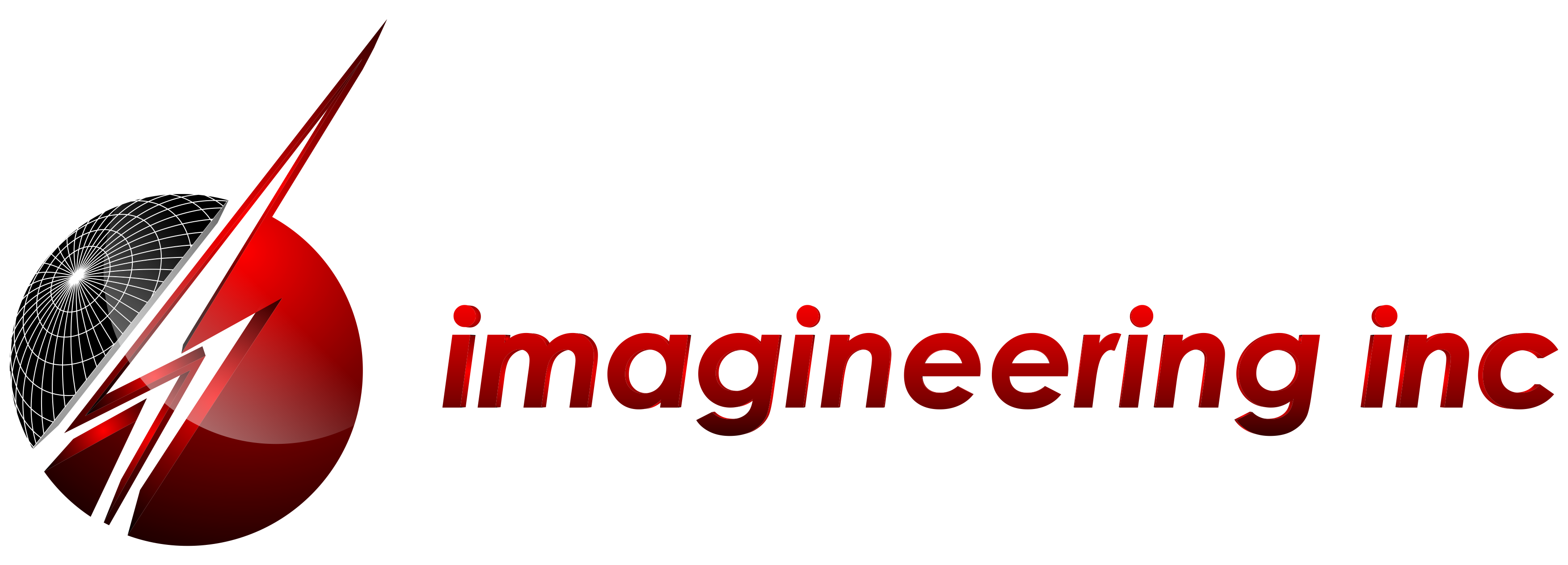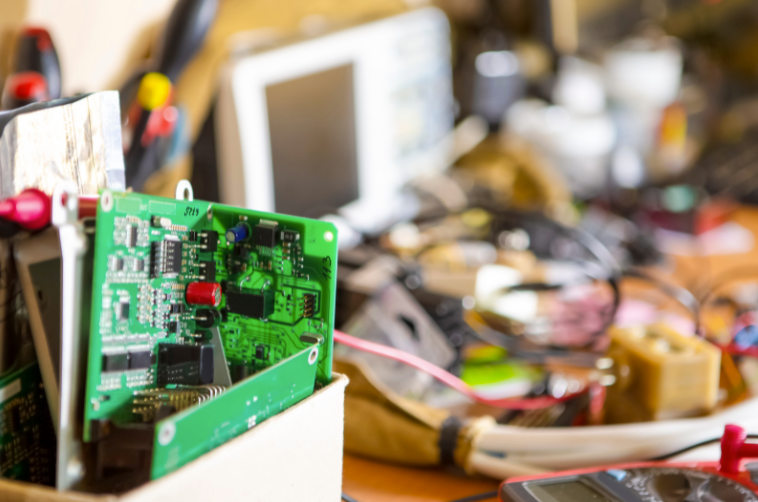Selecting PCB materials for fabrication is a critical element of the printed circuit board fabrication process. The materials you select will ultimately dictate the results of your end product.
Materials determine a product’s manufacturability while meeting temperature and electrical requirements for a printed circuit board. The quality of the signals passing through traces depends on material selection in PCBs. Before starting your next printed circuit board manufacturing process, read below for information about what materials are needed for completion.
Anatomy of a Printed Circuit Board
Before selecting PCB materials for fabrication, it is essential to understand what makes up the structure of a printed circuit board, and how each part relates to one another.
- Prepreg – A prepreg is a sheet of woven-glass fabric that holds a resin in place, which is heated to become extremely hard. It allows for the bonding of different laminates and foils. They essentially function as a means to glue the printed circuit board together.
- Copper Foil – The conductive medium that allows electric current to flow through a printed circuit board. Traces are etched into copper foil to create the electrical connections. In multi-layer printed circuit boards, holes are drilled through these layers and covered in copper to connect each layer together.
- Laminates – Laminates consist of prepregs and foils that have been laminated and cured together with heat and glass. These can be made out of a variety of thicknesses and different types of epoxy and glass waves.
- Solder Mask – An epoxy coating that covers the circuits on the printed circuit board. Printed circuit board solder mask color is typically green, but can be substituted for both practical and aesthetic purposes. This layer helps protect the conductors on the outer layers of the printed circuit board from oxidation and corrosion.
- Silk Screen – The letters printed on top of a PCB, typically in white for legibility.
Careful consideration must be made by a designer to ensure that the combination of materials for laminates are suited for the end product. These can be broken into two categories: thermal and electrical.
Thermal Properties
A printed circuit board may have to contend with extreme temperature variations. In high-heat applications, it is essential that a board continues to work without losing functionality.
Glass transition temperature (Tg) is the range in which a PCB substrate becomes softened and deforms when reaching extreme heat. In this state, the material will revert back to its original shape once it has cooled. If a PCB exceeds the glass transition temperature for too long, the material will turn to a rubbery state, permanently affecting its performance. When selecting PCB materials, it is essential to consider the glass transition temperature. As a best practice, make sure that the temperature of a PCB’s environment is 20⁰C less than the glass transition temperature of a substrate.
The glass transition temperature is, critically, not the maximum heat that a PCB can tolerate. The decomposition temperature is the point at which a PCB substrate loses at least 5% of its mass. This damage is not reversible.
When selecting PCB materials for fabrication, you must also consider thermal expansion. The coefficient of thermal expansion, or CTE, measures how much a material expands for every degree Celsius it is heated up. If the components of a printed circuit board have different CTE, they may expand at different rates during the fabrication process. It is best to keep the CTE as low as possible.
Electrical Properties
When selecting PCB materials, you should also consider the electrical properties of the materials you are using, as these will ultimately dictate their suitability for certain applications.
Material categories for printed circuit boards are measured largely by two factors: dielectric constant (Dk) vs. frequency response flatness and dielectric loss. The flatter a Dk vs. frequency response and the lower the dielectric loss, the more suitable they are for high GHz applications. This is of particular importance to high-speed printed circuit boards.
Selecting Materials for PCB Fabrication
With an understanding of the components of a printed circuit board and the electrical/thermal limitations that constrain them, printed circuit board designers must make careful determinations around selecting materials for PCB fabrication. Generally, printed circuit board materials are selected based on the upper limits of their performance. As performance increases, the cost of manufacturing rises with it – finding the balance between cost and functionality is critical for achieving success.
- FR-4 – FR-4 is the most popular PCB substrate material on the market today. They are composed of epoxy laminate sheets reinforced by glass. Both flame and water resistant, FR-4 has high tensile strength and has good strength to weight ratios. These can be further bolstered by mixing the base epoxy with additives to improve its thermal performance. FR-4 laminates tend to have the highest dielectric loss and least flat Dk vs. frequency response, making them suitable for low GHz applications such as mobile phones, computers, telecommunications, and internet infrastructure. They work best for single and double-sided printed circuit boards with less than 14 layers.
- Polyimide – Polyimide laminates provide higher temperature performance and improvement upon the electrical performance properties of FR4 substrates. They expand less during thermal cycling, making them ideal for higher layer counts. Polyimide laminates are slightly more expensive than FR-4 laminates.
- Teflon – Teflon, or PTFE, is a plastic material that provides no resistance, is extremely flexible and lightweight. It is strong, flame-resistant, and provides temperature stability, making it usable across industries in a wide variety of applications. Because of their higher cost, they are more commonly used in aerospace and military applications. They are excellent for high-speed circuitry applications, but require specialized training and equipment to manufacture, making them a more expensive alternative.
- Flexible – Critical to the design of flex PCBs, flexible laminates do not contain a woven-glass fabric, but are instead designed around a plastic film. They can be made out of polyester, but can also be designed out of polyimide or liquid crystal polymer to give them enhanced resistance to high heat applications. This allows them to flex throughout the lifetime of a product, making them ideal for applications ranging from aerospace to medical devices that are expected to move along with the wearer. Like Teflon, they also require expertise and specialized tools to manufacture.
- Other – While other laminates exist in the PCB manufacturing marketplace, they are produced in much smaller volumes than the four types mentioned above. These are generally selected to produce distinct electrical and mechanical performance, and incluse ceramic, cyanate ester, BT, and other blended systems.
Imagineering Uses The Best Materials for PCB Fabrication
At Imagineering, we use a variety of materials suitable for all types of performance and across most industries, which can be viewed on our technology roadmap. Particularly within Class 2 and Class 3 printed circuit board fabrication, material selection is of the utmost importance. Some of the materials we use include:
- Taconic
- MAGTRON
- FR 4
- ISOLA
- Polymide-Flex
- Metal Core
Imagineering is a trusted expert in manufacturing RoHS-compliant printed circuit boards. We typically use Isola and Nanya products. Our high-Tg materials are specifically formulated to provide optimal performance through multiple thermal excursions, and pass six solder tests at 288⁰C. Our resin chemistry provides ideal CAF resistance with long-term reliability for boards with small feature designs.
Between simple prototypes and complex multilayer projects, we have the resources you need to get the job done – contact us today for more information about our services.

